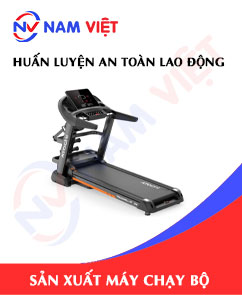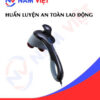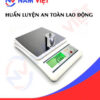Occupational Safety Training in Treadmill Manufacturing
99,000 ₫
Note: The above price is calculated for one person, the price may fluctuate depending on the number of trainees participating in the course and depending on market movements. For more accurate pricing support, please refer to the quotation table or contact our consulting staff directly.
Occupational safety is an important issue in treadmill manufacturing factories and needs to be addressed promptly to ensure the health and safety of workers, and to enhance the reputation of businesses. The Occupational safety training course is one of the effective solutions to raise awareness about accident prevention for workers participating in treadmill manufacturing.
Table of Contents
Toggle1. Overview of Treadmills
a. What is a treadmill?
A treadmill is an exercise equipment used for walking or running in place on a motorized belt controlled by electricity. The treadmill allows adjustment of the belt speed and incline to suit the user’s workout needs.
Treadmills are widely used in gyms, home fitness rooms, or sports centers to enhance health and physical fitness.

b. Types of machinery used in treadmill manufacturing
The treadmill manufacturing process includes multiple stages, so various types of machinery are used. Common machines include:
- Metal cutting and bending machines: used to cut and bend metal parts of the treadmill such as the frame, handles, connecting components, and other details.
- Metal punching machines: used to punch holes in treadmill metal parts such as cable holes, supports, and other components.
- Welding machines: used to weld metal parts together to form the frame and other components.
- Mechanical processing machines: used to process metal parts of the treadmill such as motors, gears, and other components.
- Plastic molding machines: used to mold plastic parts of the treadmill such as the running surface, casing, and other components.
- Fabric cutting machines: used to cut fabric components such as treadmill covers and protective parts.
- Industrial sewing machines: used to sew fabric components together to create covers, protective layers, and other parts.
- Printing machines: used to print logos, labels, and usage instructions on the treadmill.

c. Treadmill manufacturers in Vietnam
Currently, there are many treadmill brands in Vietnam, but some well-known brands include:
- Cardiozone: A treadmill brand from the United States, known for durability and features.
- Bodytone: A Spanish treadmill brand, designed for both beginners and experienced users.
- Proform: A U.S. brand highly rated for features and advanced technology.
- NordicTrack: Another U.S. brand recognized as a leading treadmill manufacturer.
- Reebok: Known for sports shoes and fitness equipment, including treadmills, valued for functionality and design.
- Johnson Health Tech (JHT): A Taiwanese brand with sub-brands like Matrix, Horizon, Vision Fitness, known for durability and features.
- Sportop: A Taiwanese treadmill brand known for elegant design and high functionality.
- Life Fitness: A U.S. brand regarded as a top brand in the treadmill industry, with elegant design and high functionality.
d. Specific roles in a treadmill manufacturing plant
Group 1
- Executive director, deputy director, and department heads in the treadmill manufacturing plant.
Group 2
- Safety officers: manage workplace safety, design safety procedures, and supervise employees to comply with safe working practices.
Group 3
- Component procurement: Mechanical engineers purchase components for treadmill assembly, including motors, belts, frames, and other parts.
- Assembly: Workers assemble treadmill parts, including frame, motor, belt, and electronic components.
- Quality inspection: Components and finished treadmills are inspected to ensure they meet technical standards.
- Packing and delivery: After quality inspection, treadmills are packed and shipped to distributors or direct customers.
Group 4
- Office, service, sales, and marketing roles.
- Production management, quality management, human resources management, materials management, and accounting/finance management.
- Design: Designers create technical drawings, calculations, and designs for treadmill components.

2. Overview of occupational safety training for treadmill manufacturing
This article focuses on issues related to Group 3, as Group 3 directly participates in production and faces the highest occupational safety risks. More information on other groups can be found here.
a. What is Group 3 occupational safety training?
- Group 3 occupational safety training consists of courses that provide workers with awareness and methods to prevent workplace accidents.
- The training helps workers identify and avoid hazards, minimizing risks of accidents during work.
REGISTER FOR OCCUPATIONAL SAFETY TRAINING
b. Training duration
Initial safety training
- Total training time is at least 24 hours, including testing time.
- 8 hours of theory on safety policies and labor hygiene laws
- 8 hours of theory on basic occupational safety and hygiene knowledge
- 4 hours of theory on specialized training content
- 2 hours of practical exercises on specialized training content
- 2 hours of theory exam at the end of training
The training center may divide the training into multiple sessions depending on worker schedules. Typically, there are six sessions over three days, provided the manufacturing company can arrange continuous training.
Periodic safety training
- Before the occupational safety card expires, workers seeking renewal must complete periodic occupational safety training, with training duration at least 50% of the initial training time.
Explanation: Total periodic occupational safety training is at least 12 hours, including testing time. After completing the course and passing the exam, the worker will be reissued and the safety card extended.
c. Training content
| No. | TRAINING CONTENT | TRAINING DURATION (HOURS) | |||
| Total | Including | ||||
| Theory | Practical | Test | |||
| I | Safety policies and labor hygiene laws | 8 | 8 | 0 | 0 |
| 1 | Overview of legal documents on occupational safety and hygiene. | 6 | 6 | ||
| 2 | Standards and technical regulations for occupational safety and hygiene. | 1 | 1 | ||
| 3 | Specific regulations of state management agencies regarding safety and hygiene in new construction, expansion, or renovation of facilities, and the use, storage, and inspection of machines, equipment, materials, and substances with strict safety requirements. | 1 | 1 | ||
| II | Basic knowledge of occupational safety and hygiene | 8 | 8 | 0 | 0 |
| 1 | Basic knowledge of hazards and harmful factors at the workplace. | 4 | 4 | ||
| 2 | Methods to improve working conditions. | 1 | 1 | ||
| 3 | Safety culture in production and business. | 1 | 1 | ||
| 4 | Rights and obligations of employers and employees; occupational safety and hygiene policies; roles of safety network members. | 1 | 1 | ||
| 5 | Safety and hygiene regulations, signage, use of safety equipment, personal protective equipment, first aid skills, and occupational disease prevention. | 1 | 1 | ||
| III | Specialized training content | 6 | 4 | 2 | 0 |
| Comprehensive knowledge of machines, equipment, hazardous substances; risk analysis, assessment, management of safety and hygiene; safe working procedures with machines, equipment, and substances with strict safety requirements. | 6 | 4 | 2 | ||
| IV | Final safety training test | 2 | 2 | 0 | 0 |
| Total | 24 | 22 | 2 | ||
See more training content for all 6 groups
d. Occupational safety card
After completing the safety training and passing the exam, workers will be issued an occupational safety card (commonly referred to as Group 3 safety certificate).
The Group 3 safety card includes details such as name, date of birth, specific job and work environment, training duration, official stamp, and signature confirming course completion.
According to Clause 2 of Article 24 of Decree 44/2016/ND-CP, there are two cases:
- If the employer and employee have a labor contract, the employer must sign, stamp, and validate the safety card for the trained worker after completing the course and passing the exam.
- If the worker is freelance or seasonal, without a labor contract, the training unit must sign, stamp, and validate the safety card after the worker completes the course and passes the exam.

3. Identifying hazards affecting employees during treadmill production
Some potential hazards that may affect employees’ health and safety during treadmill production include:
- Risk of peripheral and central injuries: Employees often work with mechanical parts, engines, and other treadmill components, which can lead to hand, foot, finger, and body injuries during treadmill operation.
- Risk of occupational accidents: Workers during production may encounter accidents due to malfunctioning or improperly operated equipment.
- Risk of fire and explosion: Employees working in treadmill manufacturing may handle electrical devices and current-carrying systems, which could lead to fire and explosion hazards.
- Risk of chemical exposure: During treadmill production, employees may come into contact with chemicals such as grease or cleaning agents, which can cause skin irritation, allergies, or other health issues.
- Electrical hazards: If electrical equipment in the factory is not regularly maintained, properly insulated, or waterproofed, it may pose an electric shock risk to workers during production.
- Lighting hazards: Continuous work under artificial lighting can cause eye strain, glare, headaches, and other health issues.
4. Common occupational accidents for employees during treadmill production
Common occupational accidents for employees during treadmill production may include:
- Back injuries: Employees in treadmill manufacturing often have to lift and move heavy machine parts. Improper lifting techniques can result in back injuries.
- Eye injuries: Employees working with small parts and engines may suffer eye injuries if protective goggles are not worn properly.
- Hearing loss: Noise from treadmills and other factory equipment can lead to hearing loss if employees do not use ear protection.
- Hand cuts: During assembly, employees may encounter sharp blades, posing a risk of hand cuts.
- Foot injuries: Employees may suffer foot injuries if proper protection is not used while working around machinery.

5. Safety measures when participating in treadmill production
Some safety measures when participating in treadmill production:
- Fully equip personal protective equipment: including helmets, safety glasses, masks, gloves, anti-static clothing, anti-static shoes, safety harnesses, etc.
- Ensure good ventilation and adequately arranged fire safety equipment to guarantee safe working conditions.
- Establish clear production procedures, ensure compliance, avoid overheating and explosions during use.
- Train and educate employees on safety knowledge, skills, and environmental protection.
- Maintain clean and safe working conditions to prevent hazards to employee health.
- Use safety devices to minimize potential occupational accidents during production.
- Regularly inspect, maintain, clean, and repair equipment and machinery to ensure effective and safe operation.
- Enhance supervision and product quality control to ensure products meet requirements and are safe for use.
- Conduct risk assessment, evaluation, and analysis related to occupational safety to identify corrective measures and enhance safety levels.
- Adjust production processes if necessary to minimize potential hazards and risks for employees.
- Periodically conduct occupational environment monitoring in factories, collect and analyze harmful factors affecting employees, and adjust to reduce hazards to prevent occupational diseases.
6. Benefits of occupational safety training for treadmill production
An Toan Nam Viet provides your company with the following benefits after completing occupational safety training courses according to the regulations of Decree 44/2016/ND – CP on occupational safety and hygiene for companies and enterprises.
- Employees can identify potential occupational hazards and take preventive measures to avoid accidents.
- Your company can establish risk prevention measures in production, operation, and maintenance processes.
- Reduce costs associated with potential safety incidents.
- Uninterrupted production increases labor productivity and product quality.
- Comply with occupational safety laws and avoid legal risks.
- Create credibility and professionalism in all aspects, thereby enhancing your company’s brand.
Nam Viet’s training courses serve as a solution to prevent and protect individuals from external hazards, helping them avoid injuries or, in severe cases, fatal incidents.
REGISTER FOR OCCUPATIONAL SAFETY TRAINING SERVICES
7. Customer feedback after completing occupational safety training for treadmill production
An Toan Nam Viet has years of experience accompanying numerous businesses in Vietnam, particularly in the southern provinces. This responsibility is extremely valuable to Nam Viet, which is why its occupational safety training has been increasingly professional. The motivation for Nam Viet’s growth comes from positive feedback and suggestions from businesses. Below are feedbacks from partners we have served.
Bac Nam E&C Investment and Construction Joint Stock Company
“My first experience using An Toan Nam Viet’s services surprised me with the 24/7 enthusiastic support from the consulting team. Class organization was quick and convenient for our company. Thank you very much for Nam Viet’s service!”
Hoa Dat Construction and Trading Joint Stock Company
“Nam Viet’s services greatly helped us simplify occupational safety and complete safety documentation for the work process. The consulting team was enthusiastic and timely in addressing our questions. 5 stars for Nam Viet.”
See more customer interviews after using the services of An Toan Nam Viet
8. Occupational Safety Training Capabilities of An Toan Nam Viet
An Toan Nam Viet is a reputable and high-quality occupational safety training center in Vietnam. Safety training sessions are continuously conducted at factories, production workshops, or construction sites nationwide (all 63 provinces in Vietnam).
REGISTER FOR OCCUPATIONAL SAFETY TRAINING SERVICES
Occupational Safety Training License
- An Toan Nam Viet has been inspected and certified by the Department of Safety under the Ministry of Labor, War Invalids, and Social Affairs, granting full certification for occupational safety training operations. This further strengthens our occupational safety training capabilities.

Training Materials and Lectures
- Before being included in occupational safety training courses, materials are reviewed to ensure accuracy and effectiveness.
- Instructors’ teaching methods are standardized according to An Toan Nam Viet standards, developed by experts in occupational safety and hygiene training to maximize knowledge retention for learners.
Facilities
- Controlling classroom factors affecting training increases teaching efficiency and learners’ knowledge retention.
- Our training-support facilities provide spacious classrooms meeting standards for area, lighting, and training equipment.
9. Nationwide reputable occupational safety training center
At An Toan Nam Viet, we prioritize the professionalism of occupational safety training. For us, teaching workers to protect themselves equips them with safety tools in their livelihood, contributing to national development.
To ensure effective training, we meticulously prepare every detail—from tools and teaching equipment to curriculum, materials, sound, and lighting.
Our occupational safety instructors are experienced experts, some with research projects identifying hazards across various professions and preventive methods.
Lectures are practical, lively, and easily understood by employees, making learners comfortable and enhancing knowledge retention. All instruction adheres strictly to Decree 44/2016/ND-CP.
Employees learn hazard prevention measures and self-protection strategies, applying them appropriately in real work scenarios.
Our training center proudly provides professional and reputable occupational safety training with the following advantages:
- Competitive training costs while ensuring high quality.
- Flexible training schedule according to company production needs.
- Fast certification procedures complying with legal regulations.
- Experienced instructors with long-standing expertise.
- Classrooms control factors affecting training to increase teaching efficiency and learner knowledge retention.
- Courses are tailored to occupational safety practices in enterprises.
- An Toan Nam Viet works diligently and professionally to support clients accurately and promptly.

10. Additional references for occupational safety training in treadmill production
- Occupational safety materials for treadmill production
- Occupational safety training material set
- Occupational safety training test set
- Occupational safety training curriculum for treadmill production
- Occupational safety multiple-choice test for treadmill production
1 review for Occupational Safety Training in Treadmill Manufacturing
No comments yet















namchinh.haiphong341
Dịch vụ huấn luyện an toàn lao động rất tốt nhé!